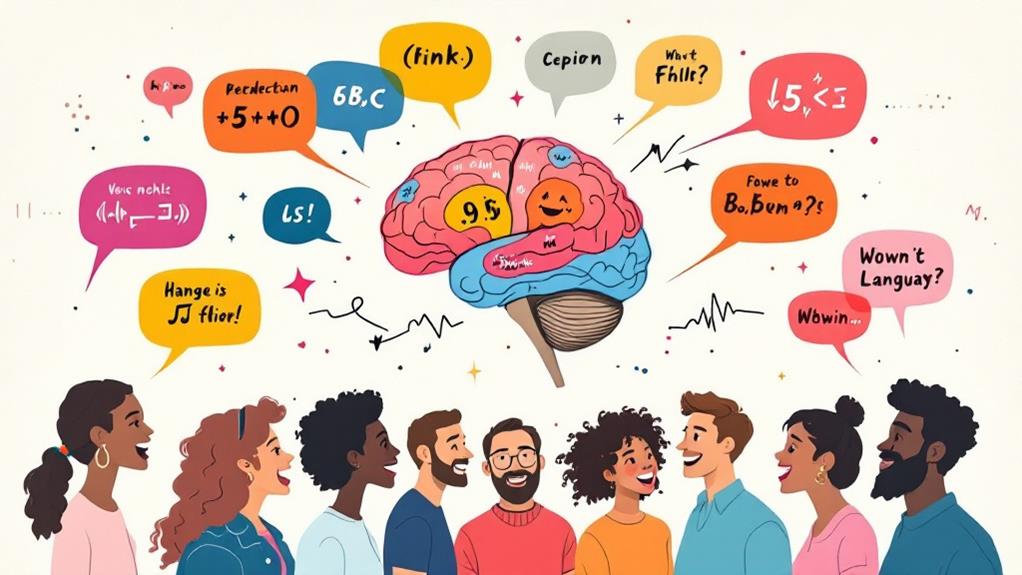What Is the Science Behind Accents? Exploring Linguistic Variation

When you hear an accent, you're experiencing a blend of rhythm, intonation, and pronunciation shaped by geography, culture, and history. Accents arise from migration, media, and education, influencing how speech sounds are perceived and produced. Your brain, specifically areas like Broca's and Wernicke's, orchestrates this symphony of speech through neural pathways that adapt and learn. Social circles, family dynamics, and environmental sounds play their part in molding your unique vocal fingerprint. Accents reveal your cultural identity, sometimes leading to biases, but they ultimately enrich personal connections. There's a deeper tapestry behind each voice that might surprise you.
The Definition of Accents
When you investigate the world of accents, you'll find that they aren't just about the way people sound. Accents are a fascinating blend of accent features, such as rhythm, intonation, and pronunciation, which contribute to the unique sound of speech. Accent perception plays a key role in how we identify and classify these differences. As you listen closely, you'll notice accent variation, which occurs naturally due to geographical, social, and cultural influences.
Understanding accents involves accent classification, where specific patterns and sounds are grouped to help with accent recognition. This process is crucial for linguists who study how accents develop and change over time. Accent influences can stem from a variety of factors, including migration, media exposure, and even education.
If you're interested in mastering a new accent, accent training and accent modification come into play. These methods help in adopting or refining accent features to suit personal or professional needs. They can improve communication, making interactions smoother and more effective. Ultimately, accents are a rich and dynamic element of language, reflecting the diversity and complexity of human communication. By probing into these elements, you gain a deeper appreciation for the intricacies of speech.
Historical Roots of Accents
To truly understand accents, you must investigate their historical roots. Accents don't just appear; they're shaped by complex forces over time. Historical migration plays a key role as people move and settle in new areas, bringing their regional dialects with them. These dialects mix with local languages, leading to linguistic evolution. This constant evolution results in phonetic shifts, where certain sounds change or merge, creating new accent characteristics.
Colonial influences also contribute greatly. When colonizers impose their language on a region, new accents emerge through language contact. This blending creates unique linguistic patterns that distinguish one area from another. Social stratification further impacts accents, as different social classes may adopt or reject certain speech patterns. This creates a dynamic where accents can signify social status or group identity.
Accent diffusion occurs when linguistic traits spread from one group to another, often due to trade, cultural exchange, or media. Over time, these influences blend, morph, and solidify into the distinct accents we recognize today. By examining these historical roots, you gain a deeper appreciation of the intricate tapestry of accents that enrich our global linguistic landscape.
Phonetics and Phonology

At the heart of understanding accents lies the study of phonetics and phonology. You'll find that phonetics investigates the articulatory features and acoustic properties of speech sounds. Phonology, on the other hand, examines the abstract, cognitive aspects of these sounds. Together, they explain why people from different regions sound distinct. Phonetic variations occur due to shifts in articulatory features like vowel shifts or changes in consonant clusters. For instance, how you pronounce "car" might differ depending on your regional dialect.
Suprasegmental patterns, such as intonation and stress, also play an essential role in shaping accents. These patterns are like the melody of speech, influencing how you perceive different accents. In tone languages, pitch variations are linguistic markers that can change a word's meaning entirely. Understanding these elements helps you grasp why accents are so diverse and fascinating.
Speech perception is about how you interpret these sounds and patterns. Your brain recognizes these variations and assigns meaning based on your linguistic background. Recognizing these intricacies can deepen your appreciation for the rich tapestry of accents across the globe. Welcome the complexity and enjoy the diversity they bring to language.
Neurological Basis of Speech
In exploring the neurological basis of speech, you'll find that the brain's intricate network plays a vital role in how we produce and understand language. The brain's complexity, with its specialized regions and pathways, guarantees that speech production and comprehension happen seamlessly. Numerous neurological mechanisms are at play, allowing you to articulate thoughts into words and understand others.
Consider these awe-inspiring aspects:
- Broca's Area: This region in your frontal lobe is fundamental for speech production. When you speak, it coordinates the muscles that let you form words, affecting fluency and coherence.
- Wernicke's Area: Located in the temporal lobe, this area is significant to understanding language. It helps you make sense of spoken words, enabling meaningful communication.
- Neural Pathways: These pathways connect Broca's and Wernicke's areas, guaranteeing smooth transmission of information. They're like highways that link different parts of your brain for effective speech processing.
- Neuroplasticity: Your brain's ability to adapt and reorganize is vital. It allows you to learn new accents and languages by forming new neural connections, showcasing its incredible flexibility.
Appreciating these elements highlights the astounding power and adaptability of your brain.
The Role of Environment

Your environment plays a crucial role in shaping your accent and language skills. The sounds you hear daily, known as your acoustic environment, influence how you perceive and produce speech. If you grow up in a place with distinct regional sounds, those sounds become part of your speech patterns. For instance, living near a lively city might expose you to a variety of accents, whereas a rural setting might have a more uniform soundscape. These variations contribute to the unique way you speak.
Geographic factors also greatly impact your accent. Different regions have unique linguistic histories and influences, which shape local dialects. If you were raised in the southern United States, you might have picked up the Southern drawl. Meanwhile, growing up in the northeastern states could give you a sharper, more clipped accent. The climate and landscape can even play a part, as they affect daily life and interactions, further embedding specific linguistic traits.
Ultimately, your accent is a reflection of the places you've lived and the sounds you've been exposed to throughout your life. This connection between environment and accent highlights the intricate ways our surroundings shape who we are and how we communicate.
Social Influences on Accent
Imagine a lively café where conversations overlap like a symphony of voices, each contributing to the social tapestry that shapes your accent. Social influences are powerful, molding how you speak in subtle and profound ways. Your peer influence can lead you to adopt certain speech patterns, especially if you want to fit in or establish a group identity. As you move through different phases of life, maturity factors also play a role in how your accent evolves.
Your educational background influences the formality or informality of your speech, while media exposure introduces new vocabulary and pronunciations that might seep into your everyday conversations. Family dynamics are another layer, as the accents of parents and siblings often provide the foundational sounds that shape yours.
Regional stereotypes can pressure you into altering your accent to either accept or distance yourself from them, particularly if you're seeking social mobility. The accents you choose to adopt or discard tell a story about your progression through life. Consider how these factors impact your accent:
- Peer Influence: Who do you want to sound like?
- Maturity Factors: How has your speech changed over time?
- Family Dynamics: What sounds feel like home?
- Social Mobility: Where do you want your voice to take you?
Cultural Impact on Language

As personal interactions shape accents, cultural impact broadens the conversation to encompass entire linguistic landscapes. When you think about cultural exchange, it's not just about trading goods or customs but also about how language evolves. You'll notice that migration patterns play a significant role in this evolution. As people move and settle in new areas, they bring their languages and accents with them. This leads to the formation of regional dialects, reflecting a blend of languages and cultural influences.
Social integration further affects language. When you engage with diverse communities, you're participating in a dynamic process where accents and dialects plunge over time. Community identity is often tied to these regional dialects, serving as a badge of cultural representation. People hold onto their distinctive speech patterns as a form of linguistic preservation, ensuring their cultural heritage isn't lost.
Cultural impact on language also highlights the importance of maintaining these unique dialects within a globalized world. By understanding how cultural forces shape language, you contribute to a broader appreciation of linguistic diversity. Ultimately, this awareness enriches both personal interactions and community connections, fostering a deeper understanding of our shared humanity.
Accents and Identity
Accents carve out a significant portion of your identity, acting like a vocal fingerprint that reveals your geographical, cultural, and social background. They play an essential role in identity formation, shaping how others perceive you and how you perceive yourself. When you speak, your accent communicates elements of your regional identity and cultural identity, linking you to a specific place and community. This connection fosters a sense of belonging and pride in your roots.
However, accent perception can lead to accent bias, where certain accents are unfairly judged or stereotyped. These accent stereotypes can affect your social identity and how you're treated in different settings. For example, you might notice:
- Acceptance or rejection: An accent can foster inclusion in one group but exclusion in another.
- Pride and self-esteem: Embracing your accent can enhance your personal identity and confidence.
- Misunderstanding: Accents might lead to assumptions about intelligence or competence.
- Connection or distance: Your accent can bring you closer to others with similar backgrounds or highlight differences.
Language Acquisition Process

In regard to understanding how people acquire language, it's vital to investigate the intricate process that begins from birth. From the very start, language exposure plays a key role. As you interact with family and community, your brain rapidly absorbs sounds and words. This is where cognitive development and social interaction come into play, both fundamental in shaping how you perceive and produce language. Phonetic awareness develops as you mimic and practice sounds, gradually refining your ability to understand and speak.
Developmental factors greatly influence this process. As a child, your brain is a sponge, making it easier to pick up dialectical differences and nuances in speech. Immersion experiences, such as living in a linguistically rich environment, amplify this ability, providing diverse linguistic input. It's fascinating how feedback mechanisms, like corrections from caregivers and peers, help fine-tune your speech patterns.
These elements contribute to the unique way you speak. Your accent reflects the sum of your experiences, shaped by the interplay of development, exposure, and environment. Dialects you've encountered and the feedback you've received all leave imprints, making your speech distinctly yours.
Global Accent Diversity
The rich tapestry of global accent diversity showcases the fascinating variations in speech across different regions and cultures. As you traverse this linguistic landscape, you'll notice how regional dialects and accent evolution reflect the unique histories and identities of speech communities. Linguistic geography plays a crucial role in shaping phonetic variation, as people in different areas develop distinctive speech patterns. Your auditory perception picks up on these nuances, allowing you to appreciate the subtle differences between accents.
Consider these thought-provoking aspects of global accent diversity:
- Migration Effects: As people move, they bring their accents with them, blending and transforming speech patterns in new environments.
- Cultural Exchange: Through interaction, accents adapt, reflecting the influence of multiple cultures and languages.
- Communication Barriers: While accents enrich communication, they can sometimes lead to misunderstandings, highlighting the need for patience and empathy.
- Language Preservation: With global integration, some unique accents risk fading away, making preservation efforts crucial for maintaining linguistic diversity.
Understanding the dynamics of accents helps you break down communication barriers and fosters a greater appreciation for the rich array of global voices. Cherish the diversity and work towards preserving these lively speech gems.



